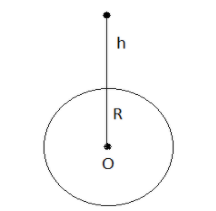Question
Question: Value of Gravitational Constant ‘G’ is \(\begin{aligned} & A)6.67408\times {{10}^{-11}}{{m...
Value of Gravitational Constant ‘G’ is
A)6.67408×10−11m3kg−1s−2B)4.67408×10−11m3kg−1s−2C)6.67408×1011m3kg−1s−2D)6.67408×10−11m3kg−2s−2
Solution
Gravitational Constant is the universal constant and one should memorize its value but in case you have forgotten that value. Then find the formula through which we can find the value of the gravitational constant one of the formula is g=R2GM . We know the value of acceleration due to gravity g, Mass of the earth, and Radius of the earth.
Formula used:
Gravitational Force between two objects, one of Mass M and the other of mass m , which are separated by a distance r is given by:
F=r2GMm
Where, G is Gravitational Constant.
Also, Force = Mass !!×!! Acceleration
F=ma
Complete step by step answer:

To determine the value of the gravitational constant, firstly, let us place an object of mass m at a heighth above the earth’s surface. Then gravitational force exerted by the earth on that object is given by
F=r2GMm
Here, r = R+h
F=(R+h)2GMm
If the object of mass m is on the surface of the earth, therefore h=0 .
F=R2GMm
Also, acceleration is given as force divided by mass i.e. a=mF .
Therefore acceleration due to gravity is the gravitational force divided by the mass of the object.
But, g=R2GM
Or, G=MgR2. Substituting the value of g, M, R in this formula we easily find the value of the gravitational constant.
g=9.8ms−2R=6400km=6.4×106mM=6×1024kgG=MgR2=6×10249.8×(6.4×106)2G=6.67408×10−11m3kg−1s−2
Hence, option A is correct.
Note:
We must know that gravitational force is one of the weakest forces in nature. The Gravitational constant remains as a constant everywhere. Although acceleration due to gravity changes with altitude, depth, and rotation of earth but Gravitational constant never changes. If we compare the electrostatic force and gravitational force, we can find that gravitational force is 1036 times smaller than the electrostatic force.
